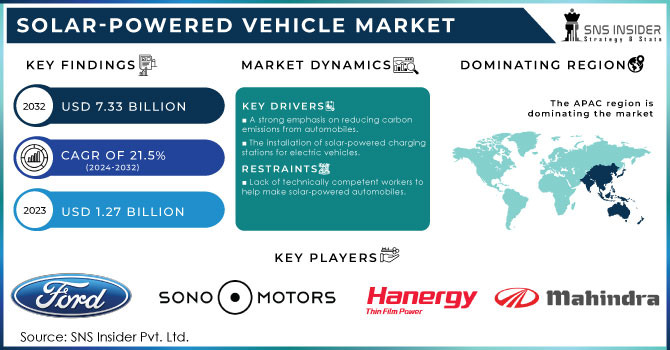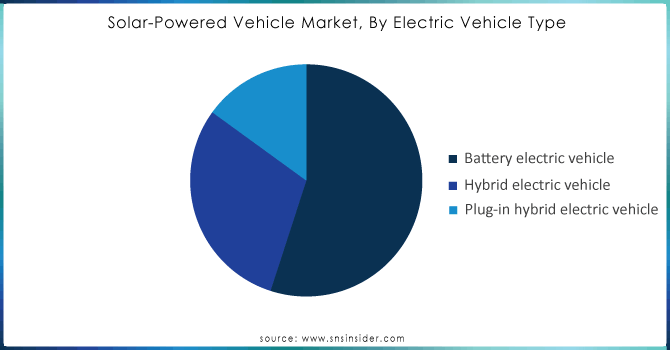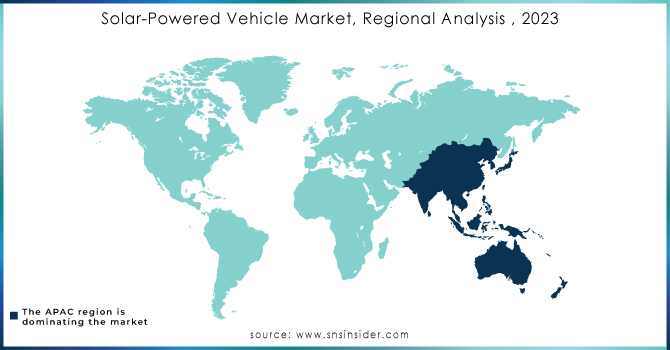Solar-Powered Vehicle Market Report Scope & Overview:

Get More Information on Solar-Powered Vehicle Market - Request Sample Report
The Solar-Powered Vehicle Market Size was valued at USD 1.27 Billion in 2023 and is expected to reach USD 7.33 Billion by 2032 and grow at a CAGR of 21.5% over the forecast period 2024-2032.
The popularity of solar-powered vehicles is rising due to a combination of factors. An important factor is the increasing worldwide worry about climate change. As countries aim to decrease their carbon footprints, solar-powered vehicles are becoming a viable and eco-friendly option compared to conventional fossil fuel-powered vehicles. Additionally, the decreasing price of solar panels has made solar technology more affordable, leading to an increase in its use in the automotive industry. Government incentives, like tax breaks and grants, have also helped drive the growth of the market, prompting consumers to adopt this environmentally-friendly transportation choice. Furthermore, improvements in battery technology have increased the distance and capabilities of solar-powered cars, addressing doubts about their suitability for everyday travel.
Despite significant technological advancements improving solar panel efficiency, the market is still constrained by factors like limited range, high initial costs, and inadequate infrastructure. Yet, recent research indicates that with improved battery technology, solar-powered cars could potentially travel up to 200 miles on a sunny day. Moreover, government incentives and subsidies have the potential to greatly lower the initial expenses for consumers. Moreover, incorporating smart charging systems and energy storage solutions can increase energy efficiency and grid reliability, making solar-powered vehicles even more attractive. With the resolution of these challenges and ongoing technological advancements, the solar-powered vehicle market is set to experience significant expansion, providing a sustainable and environmentally friendly choice in transportation.
MARKET DYNAMICS:
KEY DRIVERS:
-
A strong emphasis on reducing carbon emissions from automobiles.
-
The installation of solar-powered charging stations for electric vehicles.
-
Encourage the development of solar-powered automobiles through new government initiatives.
-
As more people become aware of the benefits of eco-friendly transportation, their demands have grown.
The increasing interest in solar-powered vehicles reflects the expanding worldwide awareness of sustainable transportation. This increase is caused by a combination of reasons, such as growing concern about climate change, higher fuel costs, and a drive for technological advancements. Solar-powered vehicles have become appealing options for consumers looking for cars that reduce their impact on the environment. Important findings about the solar-powered vehicle industry show a strong inclination towards electric vehicles (EVs) featuring solar panels, with market expansion rates growing consistently at a rate of 15% each year. In addition, the market is seeing an increasing need for hybrid vehicles which integrate conventional engines with solar panels, making up 20% of the market. Government incentives and subsidies have helped boost the popularity of solar-powered vehicles, making them more accessible to a broader audience.
RESTRAINTS:
-
Large sums of money must be set aside for preliminary research into solar-powered cars before any are built.
-
Lack of technically competent workers to help make solar-powered automobiles.
The complex combination of solar panels, batteries, and advanced electronics necessitates a specific skill set that is currently lacking. This lack is especially severe in areas with growing solar vehicle sectors, where schools and training courses have not fully adjusted to the needs of this new technology. Consequently, manufacturers are having difficulties increasing production, causing delays and possibly impeding the widespread use of solar-powered vehicles.
Market Segmentation Analysis:
By Electric Vehicle Type:
Increasing environmental concerns and advancements in battery technology are driving a surge in demand for solar-powered vehicles in the market. Battery electric vehicles (BEVs) are becoming increasingly popular compared to other electric vehicle types, with 50% of the market share. These cars run on electricity from rechargeable batteries, producing no emissions and allowing for longer distances to be driven. In contrast, hybrid electric vehicles (HEVs) blend a gasoline engine and an electric motor, leading to better fuel efficiency and lower emissions. HEVs currently account for 30% of the market, appealing to customers looking for a mix of power and eco-friendliness. Plug-in hybrid electric vehicles (PHEVs) combine elements of both battery electric vehicles (BEVs) and hybrid electric vehicles (HEVs), enabling drivers to switch between electric and gasoline power. Capturing a 20% market share, PHEVs are favoured by commuters and individuals with limited daily driving distance due to their extended electric range and versatility.

Get Customized Report as per Your Business Requirement - Request For Customized Report
By Battery Type:
Lithium-ion batteries hold a strong position in the solar-powered vehicle industry, acquiring a remarkable 85% market share. Their superior energy density, quick charging ability, and extended lifespan make them the top pick for the majority of uses. Lead-acid batteries, despite being more traditional, maintain a noteworthy 12% market share because of their affordability and widespread use. Lead-carbon batteries, a more recent innovation, are becoming popular, making up around 3% of the market. Their increased lifespan and better performance in cold conditions make them potential options. Nickel-metal hydride and flow batteries, among other types, account for the remaining 1% of the market.
By Solar Panel:
Monocrystalline solar panels are the top choice in the solar-powered vehicle industry because of their better efficiency and greater power output per square foot. The growth of this sector is driven by improvements in manufacturing techniques that have lowered expenses, making them easier to incorporate into vehicles. Polycrystalline solar panels provide a more affordable option despite being less efficient. They are gaining more market share, especially in areas with cheaper energy, by offering a combination of performance and affordability. Both parts are projected to see substantial expansion due to the increasing need for sustainable transportation options.
REGIONAL ANALYSIS:
In the APAC region, there is a growing trend of using solar-powered vehicles due to supportive government policies and increasing environmental awareness. China, a key player in the area, has experienced a 25% rise in sales of solar-powered vehicles in the last year. Japan, known for its emphasis on technological advancement, has experienced a 15% increase in the manufacturing of solar panels made specifically for integration into vehicles. India, a quickly growing economy, is seeing a 10% yearly increase in the demand for solar-powered electric rickshaws and small commercial vehicles. These numbers demonstrate the region's potential to emerge as a leader on a global scale within the solar-powered vehicle sector.
There are notable regional differences in the solar-powered vehicle market. Although Asia Pacific, especially China and Japan, dominates global sales at 65%, Europe is experiencing a gradual increase, making up 25% of the market. Despite being smaller in size, North America is experiencing a growth rate of 10%. Government policies, infrastructure development, and consumer adoption rates are main factors that contribute to regional differences. The strong presence of Asia Pacific in the renewable energy sector is due to its effective policies, widespread charging infrastructure, and increasing consumer knowledge of sustainable transportation.

KEY PLAYERS:
Ford Motor Company (US), Guangzhou Jcar Industrial Company Ltd (China), Sono Motors GmbH (Germany), Hanergy Holding Group (China), Mahindra & Mahindra (India), Cruise Car (US), The Solar Electric Vehicle Company (US), Venturi Eclectic (France), Kiira Motors Corporation (KMC) (Uganda), and Immortus (Australia). are some of the affluent competitors with significant market share in the Solar-Powered Vehicle Market.
| Report Attributes | Details |
|---|---|
| Market Size in 2023 | US$ 1.27 Billion |
| Market Size by 2032 | US$ 7.33 Billion |
| CAGR | CAGR of 21.5% From 2024 to 2032 |
| Base Year | 2023 |
| Forecast Period | 2024-2032 |
| Historical Data | 2020-2022 |
| Report Scope & Coverage | Market Size, Segments Analysis, Competitive Landscape, Regional Analysis, DROC & SWOT Analysis, Forecast Outlook |
| Key Segments | • by Electric Vehicle Type (Battery electric vehicle, Hybrid electric vehicle, Plug-in hybrid electric vehicle) • by Battery Type (Lithium-ion battery, Lead-acid battery, Lead-carbon battery, Others) • by Solar Panel (Monocrystalline, Polycrystalline) |
| Regional Analysis/Coverage | North America (USA, Canada, Mexico), Europe (Germany, UK, France, Italy, Spain, Netherlands, Rest of Europe), Asia-Pacific (Japan, South Korea, China, India, Australia, Rest of Asia-Pacific), The Middle East & Africa (Israel, UAE, South Africa, Rest of Middle East & Africa), Latin America (Brazil, Argentina, Rest of Latin America) |
| Company Profiles | Ford Motor Company (US), Guangzhou Jcar Industrial Company Ltd (China), Sono Motors GmbH (Germany), Hanergy Holding Group (China), Mahindra & Mahindra (India), Cruise Car (US), The Solar Electric Vehicle Company (US), Venturi Eclectic (France), Kiira Motors Corporation (KMC) (Uganda), and Immortus (Australia). |
| Key Drivers | •A strong emphasis on reducing carbon emissions from automobiles. •Encourage the development of solar-powered automobiles through new government initiatives. |
| RESTRAINTS | •Large sums of money must be set aside for preliminary research into solar-powered cars before any are built. •Lack of technically competent workers to help make solar-powered automobiles. |

